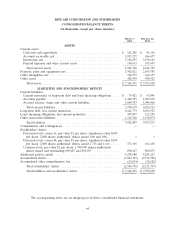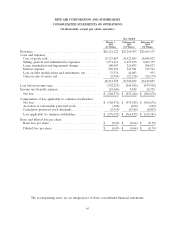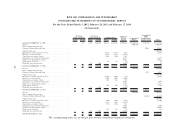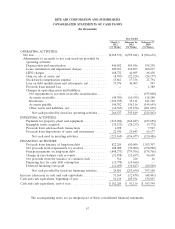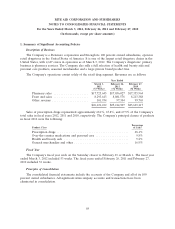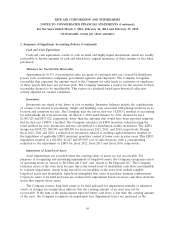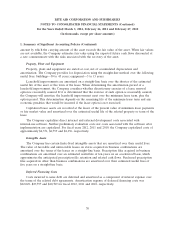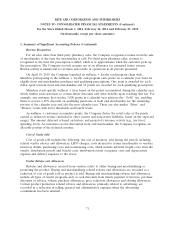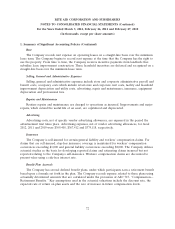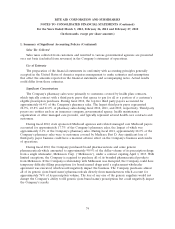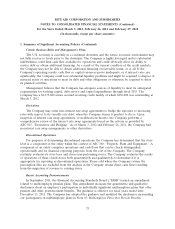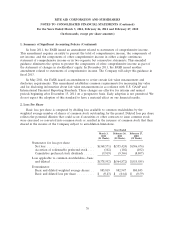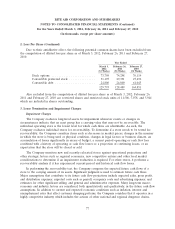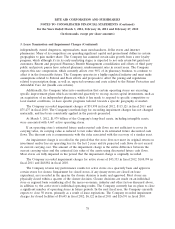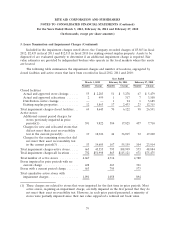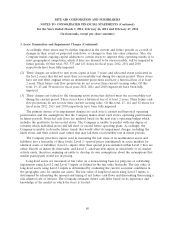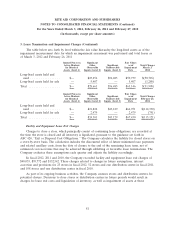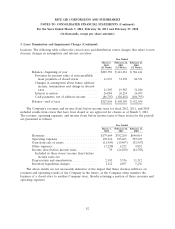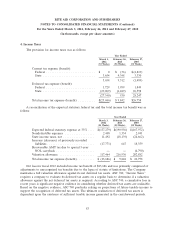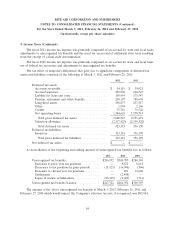Rite Aid 2012 Annual Report Download - page 74
Download and view the complete annual report
Please find page 74 of the 2012 Rite Aid annual report below. You can navigate through the pages in the report by either clicking on the pages listed below, or by using the keyword search tool below to find specific information within the annual report.RITE AID CORPORATION AND SUBSIDIARIES
NOTES TO CONSOLIDATED FINANCIAL STATEMENTS (Continued)
For the Years Ended March 3, 2012, February 26, 2011 and February 27, 2010
(In thousands, except per share amounts)
1. Summary of Significant Accounting Policies (Continued)
Sales Tax Collected
Sales taxes collected from customers and remitted to various governmental agencies are presented
on a net basis (excluded from revenues) in the Company’s statement of operations.
Use of Estimates
The preparation of the financial statements in conformity with accounting principles generally
accepted in the United States of America requires management to make estimates and assumptions
that affect the amounts reported in the financial statements and accompanying notes. Actual results
could differ from those estimates.
Significant Concentrations
The Company’s pharmacy sales were primarily to customers covered by health plan contracts,
which typically contract with a third party payor that agrees to pay for all or a portion of a customer’s
eligible prescription purchases. During fiscal 2012, the top five third party payors accounted for
approximately 66.4% of the Company’s pharmacy sales. The largest third party payor represented
22.9%, 23.8% and 21.2% of pharmacy sales during fiscal 2012, 2011, and 2010, respectively. Third party
payors are entities such as an insurance company, governmental agency, health maintenance
organization or other managed care provider, and typically represent several health care contracts and
customers.
During fiscal 2012, state sponsored Medicaid agencies and related managed care Medicaid payors
accounted for approximately 17.7% of the Company’s pharmacy sales, the largest of which was
approximately 2.1% of the Company’s pharmacy sales. During fiscal 2012, approximately 28.2% of the
Company’s pharmacy sales were to customers covered by Medicare Part D. Any significant loss of
third-party payor business could have a material adverse effect on the Company’s business and results
of operations.
During fiscal 2012, the Company purchased brand pharmaceuticals and some generic
pharmaceuticals which amounted to approximately 90.9% of the dollar volume of its prescription drugs
from a single wholesaler, McKesson Corp. (‘‘McKesson’’), under a contract expiring April 1, 2013. With
limited exceptions, the Company is required to purchase all of its branded pharmaceutical products
from McKesson. If the Company’s relationship with McKesson was disrupted, the Company could have
temporary difficulty filling prescriptions for brand named drugs until a replacement wholesaler
agreement was executed, which would negatively impact the business. The Company purchases almost
all of its generic (non-brand name) pharmaceuticals directly from manufacturers which account for
approximately 76% of its prescription volume. The loss of any one of the generic suppliers would not
disrupt the Company’s ability to fill generic (non-brand name) prescriptions but could negatively impact
the Company’s results.
74


